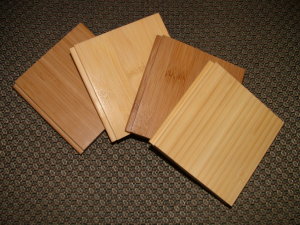DEAR TIM: A wood floor is in our immediate future. My husband and I have been debating the different types and I am very interested in bamboo flooring. But my husband thinks it is junk. What is the scoop on bamboo? Is it a good flooring material? What are its good and bad points? Is it just a fad? Does it require special care after it is installed? Monica R., Allentown, PA
DEAR MONICA: Bamboo floors are not junk and I don't believe bamboo is a fad. They are a superb building material that is quite possibly one of the most ecologically-friendly products I can think of. When you hold a piece of bamboo flooring in your hand, you would swear it comes from a tree as its weight and density are just like wood. But in fact, bamboo is a grass that grows up to 40 feet tall in just 4 years. Harvested by hand in many managed bamboo forests, the extensive root system creates new bamboo shoots in very short order. No replanting is necessary.
The bamboo plant is much like a straw as it is hollow in the center. Mature plants have a wall thickness of up to one inch and the stalks taper as they get taller. The stalks are milled and flat strips are cut from the thick plant walls. These strips are boiled in a solution of lime and boric acid which drives out the starch in the plant that attracts wood-destroying insects. Once dry, these non-toxic chemicals are fantastic termite repellents and they also are toxic to a wide variety of wood fungi that cause wood rot.

Solid bamboo can come as either a flat product made of horizontal strips or a sleek vertical product that has many thin strips glued together that stand on edge. The vertical bamboo makes for an extremely distinctive floor once installed. The engineered bamboo flooring combines bamboo as the finished wear layer and either plywood or oriented strand board as the core.
You can purchase bamboo flooring as a raw or finished product from the factory. The prefinished bamboo flooring is ready to install. This prefinished flooring can have up to 10 layers of crystal-clear finish that has a scratch-resistant topcoat. Raw bamboo flooring can be sanded in the field, stained and finished like traditional hardwood flooring. It doesn't require any special care.
Bamboo is installed in the same fashion as traditional wood floors and modern laminate flooring. It can be nailed or glued to a subfloor or it can be installed as a floating floor system where each piece interlocks with another and the individual pieces create a giant slab of flooring that floats on top of the subfloor.
The subfloor beneath bamboo needs to be structurally sound, clean and free of all debris and it needs to be in the same plane. It would be ideal if the subfloor were level, but if not, there can't be more than a 3/16ths inch difference in elevation in a ten-foot radius.
Wood subfloor systems as well as concrete need to be very dry. Wood should have a moisture content no higher than 12 percent. Concrete needs to cure thoroughly and a vapor retarder needs to be in place under the concrete slab to stop moisture movement from the soil into the bamboo. Crawl spaces below wood floor systems must also have a high-quality vapor retarder in place over the soil.
Squeaks between the bamboo flooring and the subfloor can be minimized or eliminated if 15-pound asphalt felt paper is installed over the subfloor before the bamboo is installed. Use regular asphalt shingles to fill low spots in the subfloors in case they do not meet minimum flatness specifications. The asphalt shingles will not degrade over time as some floor leveling compounds tend to do.

It is possible to make mistakes when installing bamboo flooring. Perhaps the biggest mistake is to ignore the mandatory acclimatization requirement. Since bamboo is a hygroscopic material that expands and contracts with changes in moisture content, it needs to become equalized with the moisture content of the room where it will be installed. This means the flooring must be brought into the space where it will be installed and allowed to sit for a minimum of three days. Often you must open the boxes and spread out the material so the bamboo flooring can get comfortable.
Be sure to check the moisture content of wood subfloors and slabs before you start the installation. Follow the manufacturers recommendations to the letter. Delay installation until you meet the minimum moisture requirements.